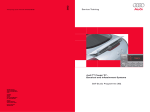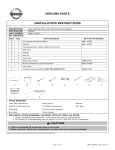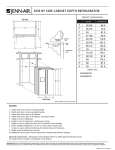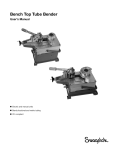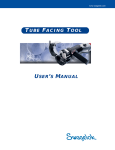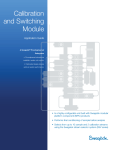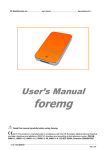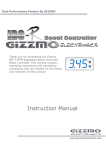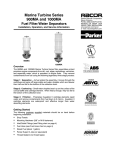Download Electric Tube Bender User's Manual, (MS-13-138,R4)
Transcript
www.swagelok.com E l e c t r i c Tu b e B e n d e r U s e r ’s M a n u a l Table of Contents Operator’s Safety Summary . . . . . . . . . . . . . . . . . . . . . . . . . . . . . . . . . . . . . . . . . . . . . . . . . . . . . . . . . . . . . . . . . . . 3 Grounding and Extension Cord Information . . . . . . . . . . . . . . . . . . . . . . . . . . . . . . . . . . . . . . . . . . . . . . . . . . . 3 Statements . . . . . . . . . . . . . . . . . . . . . . . . . . . . . . . . . . . . . . . . . . . . . . . . . . . . . . . . . . . . . . . . . . . . . . . . . . . 3 Symbols . . . . . . . . . . . . . . . . . . . . . . . . . . . . . . . . . . . . . . . . . . . . . . . . . . . . . . . . . . . . . . . . . . . . . . . . . . . . . 3 Safety Features . . . . . . . . . . . . . . . . . . . . . . . . . . . . . . . . . . . . . . . . . . . . . . . . . . . . . . . . . . . . . . . . . . . . . . . . 4 Tube Bender Technical Data . . . . . . . . . . . . . . . . . . . . . . . . . . . . . . . . . . . . . . . . . . . . . . . . . . . . . . . . . . . . . . . . . . 5 Tubing Information . . . . . . . . . . . . . . . . . . . . . . . . . . . . . . . . . . . . . . . . . . . . . . . . . . . . . . . . . . . . . . . . . . . . . . . . . . 5 Tube Bender Components . . . . . . . . . . . . . . . . . . . . . . . . . . . . . . . . . . . . . . . . . . . . . . . . . . . . . . . . . . . . . . . . . . . . 6 Digital Display Pendant . . . . . . . . . . . . . . . . . . . . . . . . . . . . . . . . . . . . . . . . . . . . . . . . . . . . . . . . . . . . . . . . . . . . . . . 6 Error Message . . . . . . . . . . . . . . . . . . . . . . . . . . . . . . . . . . . . . . . . . . . . . . . . . . . . . . . . . . . . . . . . . . . . . . . . . . . . . 6 Assembling Components . . . . . . . . . . . . . . . . . . . . . . . . . . . . . . . . . . . . . . . . . . . . . . . . . . . . . . . . . . . . . . . . . . . . . 7 Tubing Layout Single 90° Bend . . . . . . . . . . . . . . . . . . . . . . . . . . . . . . . . . . . . . . . . . . . . . . . . . . . . . . . . . . . . . . . . . . . . . . . 8 Multiple 90° Bends (Measure-Bend Method) . . . . . . . . . . . . . . . . . . . . . . . . . . . . . . . . . . . . . . . . . . . . . . . . . . 8 Multiple 90° Bends (Premeasure Method) . . . . . . . . . . . . . . . . . . . . . . . . . . . . . . . . . . . . . . . . . . . . . . . . . . . . 9 Making Offset Bends . . . . . . . . . . . . . . . . . . . . . . . . . . . . . . . . . . . . . . . . . . . . . . . . . . . . . . . . . . . . . . . . . . . 10 Springback . . . . . . . . . . . . . . . . . . . . . . . . . . . . . . . . . . . . . . . . . . . . . . . . . . . . . . . . . . . . . . . . . . . . . . . . . . . . . . 11 Bending . . . . . . . . . . . . . . . . . . . . . . . . . . . . . . . . . . . . . . . . . . . . . . . . . . . . . . . . . . . . . . . . . . . . . . . . . . . . . . . . . 11 Bending Using Auto Bend . . . . . . . . . . . . . . . . . . . . . . . . . . . . . . . . . . . . . . . . . . . . . . . . . . . . . . . . . . . . . . . . . . . . 12 Troubleshooting . . . . . . . . . . . . . . . . . . . . . . . . . . . . . . . . . . . . . . . . . . . . . . . . . . . . . . . . . . . . . . . . . . . . . . . . . . . 12 Roller Adjustment Screws . . . . . . . . . . . . . . . . . . . . . . . . . . . . . . . . . . . . . . . . . . . . . . . . . . . . . . . . . . . . . . . . . . . . 13 Roller Alignment . . . . . . . . . . . . . . . . . . . . . . . . . . . . . . . . . . . . . . . . . . . . . . . . . . . . . . . . . . . . . . . . . . . . . . . . . . . 13 Maintenance . . . . . . . . . . . . . . . . . . . . . . . . . . . . . . . . . . . . . . . . . . . . . . . . . . . . . . . . . . . . . . . . . . . . . . . . . . . . . . 14 Warranty Information . . . . . . . . . . . . . . . . . . . . . . . . . . . . . . . . . . . . . . . . . . . . . . . . . . . . . . . . . . . . . . . . . . . . . . . 15 SAVE THESE INSTRUCTIONS! –2– Operator’s Safety Summary READ AND UNDERSTAND THIS MANUAL BEFORE USING BENDER. This device is electrically powered and must be operated in a safe environment to avoid risk of fire, explosion, or electric shock. Grounding and Extension Cord Information • Bender MUST be grounded to guard against electrical shock. It is equipped with a three-wire conductor and three-prong plug to fit a grounded receptacle. ! NEVER CONNECT THE GREEN OR GREEN/YELLOW WIRE TO A LIVE TERMINAL! • Use only three-wire extension cords that have three-prong grounding-type plugs and three-pole receptacles. • The extension cord wire size must meet the following specifications: – For 0 to 50 ft (0 to 15 m), the recommended minimum wire gauge is #12 AWG (2.5 mm). – For 50 to 100 ft (15 to 30 m), the recommended minimum wire gauge is #10 AWG (4.0 mm). Statements CAUTION! Statements that identify conditions or practices that could result in damage to the equipment or other property WARNING! Statements that identify conditions or practices that could result in personal injuries or loss of life Symbols ! 4 ~ 4 CAUTION! Indicates cautionary information. WARNING! Indicates that voltage greater than 30V (ac) is present. WARNING! PINCH POINTS. Keep hands, loose clothing, and long hair away from moving parts. Serious injury can occur. WARNING! KEEP DRY. Do not expose the equipment to water or wet locations. G WARNING! l WARNING! FIRE OR EXPLOSION. Do not use equipment in a combustible or explosive atmosphere. Flammable liquids or gases could ignite. EYE PROTECTION. Eye protection must be worn while operating or working near the equipment. –3– Safety Features Emergency Stop Button Stops rotation of bend shoe and clears all settings. Auto bend function will require reprogramming. Circuit Breaker Disconnects power from outside source. Clears all settings. Receptacle with Cord/Socket Lock Plug in power cord. Tighten screw on cord/socket lock to secure power cord. –4– Tube Bender Technical Data BENDING RANGE: 1° to 110°, in 1° increments. Bending in excess of 110° may damage bender. DIMENSIONS: Vertical Position: 44 in. (112 cm) high, 29 in. (74 cm) wide, 30 in. (76 cm) deep WEIGHT: 420 lb (191 kg) POWER REQUIREMENTS: MS-TBE-1 115 V (ac) 50/60 Hz Maximum current: 13 A MS-TBE-2 230 V (ac) 50/60 Hz Maximum current: 7 A Tubing Information • All tubing should be free of scratches and suitable for bending. • Bends 1, 1 1/4, 1 1/2, and 2 in.; 25, 32, 38, and 50 mm OD tubing in a variety of wall thicknesses. • Carbon steel tubing should be soft (annealed), seamless (ASTM A179), or welded and drawn, DIN 2391-1 and DIN 2391-2 or equivalent, with a hardness of 72 HRB, HV (VPN) 130 or less. • Stainless steel tubing should be fully annealed, seamless, or welded and drawn, meeting ASTM A269, ASTM A213, EN ISO 1127, or equivalent specification, with a hardness of 90 HRB, HV (VPN) 180 or less. • The following information for bending annealed tubing is listed below in Table 1: bend radius, wall thickness limits, and minimum straight length required to make a 90° bend using the tail roller. Table 1 – Min/Max Wall Thickness ➀ Tube OD in. 1 1 1/4 1 1/2 2 ➀ Min Length 20 1/2 22 3/4 25 1/2 32 Dimensions, in. Bend Carbon Radius Steel 4 0.049/0.120 5 0.065/0.180 6 0.083/0.220 8 0.095/0.220 Tube OD mm 25 32 38 50 Stainless Steel 0.065/0.120 0.083/0.156 0.095/0.188 0.109/0.188 Min Length 520 582 648 810 Dimensions, mm Bend Carbon Radius Steel 103 1.2/3.0 126 2.0/4.0 152 2.2/4.5 203 — See the Swagelok Tubing Data catalog for suggested tubing wall thickness for use with Swagelok tube fittings. READ AND BECOME FAMILIAR WITH OPERATING INSTRUCTIONS BEFORE BENDING TUBING! This bender can be used in the vertical or horizontal position. Before using bender make sure rollers and shoe grooves are in line. See Roller Alignment (page 13). –5– Stainless Steel 1.8/3.0 2.0/4.0 2.2/4.5 3.0/5.0 Tube Bender Components Roller Towers Tube Clamps Bend Shoe Removable Tail Roller Bend Shoe Retaining Pin Roller Tower Fixed Tail Roller Roller Adjustment Screws Bridge Opening Bridge Handle Lock Error Message Digital Display Pendant LED DISPLAY – Displays degrees of rotation. An “E1” in pendant display indicates that the motor has stopped. Remove any obstruction in bend shoe, and retry the BEND or UNLOAD function. BEND – Rotates bend shoe clockwise. JOG – Rotates bend shoe clockwise in 1° increments. UNLOAD – Rotates bend shoe counterclockwise. ZERO SET – Resets pendant display to “0.” BEND SET – Stores a bend in memory. Indicator light on display (center decimal point) will flash to confirm bend is stored. AUTO BEND – Rotates bend shoe to the angle stored in memory. Auto bend indicator light (right decimal point) remains on when bending with memory. OVERRIDE – Overrides the AUTO BEND mode without erasing memory. –6– ! CAUTION! Pressing color key pad functions on the pendant causes bend shoe to rotate. Assembling Components Up Position 1 1/2 in. 1. Select and install proper tail rollers. To bend 1 1/2 in. (38 mm) OD tubing, use the fixed tail roller in the up position. For 2 in. (50 mm) OD tubing, use the fixed tail roller in the down position. (See Figure 1.) (38 mm) Down Position 2 in. To bend 1 in. (25 mm) OD tubing, use the 1 in. (25 mm) removable tail roller, securing pin in lower pin hole (up position). For 1 1/4 in. (32 mm) OD tubing, use the 1 1/4 in. (32 mm) removable tail roller, securing pin in upper pin hole. Align roller with the inside of the unit. (See Figure 2.) (50 mm) 2. Select proper roller tower; the size is indicated on roller tower. To install, lift and hold the handle lock. Insert the roller tower into proper bridge opening so that the size indicator faces you. Allow roller tower to lean against tail roller. (See Figure 3.) Figure 1 3. Select proper tube clamp; the size is indicated on clamp face. Locate the tube size on the bend shoe, and attach the tube clamp with pin, making sure the size identification faces out. (See Figure 4.) Upper Pin Hole 1 1/4 in. (32 mm) Lower Pin Hole 1 in. 4. Make sure the circuit breaker is switched to the ON position and the EMERGENCY STOP button is not engaged. (25 mm) 5. Plug the unit into an appropriate power source. The display on the pendant will illuminate. Figure 2 Roller Tower Size Indicator Roller Tower Label Location Handle Lock Figure 3 Pin Tube Clamp Size Indicator Figure 4 –7– Tubing Layout With this bender, you can form single, offset, and other bends. This section contains information for measuring and marking the tubing prior to bending. NOTE: Make all marks 360° around the tubing. Measurement Length Reference Mark Measurement Mark Bend Deduction Distance Bend Mark Illustration 1 – Single Bend 90° Single 90° Bend 1. Place a reference mark at the end of the tubing from which your measurement begins. 2. From the reference mark at the end of the tubing, measure the desired length for the bend. Make a measurement mark on the tubing. 3. Subtract the bend deduction distance (see Table 2 on page 9) from the measurement mark and make a bend mark. (The bend deduction distance is a length that compensates for the bender and tube clamp design.) 4. To bend tubing, see Bending on page 11. Multiple 90° Bends First Measurement Mark 18 in. The Measure-Bend Method 1. Follow Steps 1 to 4 above for a Single 90° Bend. 2. Using the center line of the previous 90° bend as your second reference mark, repeat Steps 2 to 4 for the second 90° bend. EXAMPLE: Using 1 1/2 in. OD tubing, make two 90° bends with measured length distances of 18 in. between bend marks. (See Illustrations 2 and 3.) 1. From the reference mark at the end of the tubing, measure 18 in. and make a measurement mark. 2. The bend deduction distance for 1 1/2 in. OD tubing in Table 2 is 9 7/8 in. 3. 18 in. – 9 7/8 in. = 8 1/8 in. Make the first bend mark at 8 1/8 in. 4. Bend tubing. 5. From the center line of the first 90° bend, measure 18 in. and make a measurement mark. 6. The bend deduction distance for 1 1/2 in. OD tubing in Table 2 is 9 7/8 in. 7. 18 in. – 9 7/8 in. = 8 1/8 in. Make the second bend mark at 8 1/8 in. from the center line of the first 90° bend. 8. Bend tubing. Reference Mark Bend Deduction Distance 9 7/8 in. Center Line Bend Mark 1 1/2 in. OD Tubing Illustration 2 – First 90° Bend Bend Mark Bend Deduction Distance 9 7/8 in. Second Measurement Mark 18 in. Note: Follow the above steps when using metric measurements. Illustration 3 – Second 90° Bend –8– Multiple 90° Bends The Premeasure Method 1. Follow Steps 1 to 3 for a Single 90° Bend. (See page 8.) 2. From the reference mark at the end of the tubing, measure the desired length for the second bend and make a measurement mark. 3. Subtract the bend deduction distance (see Table 2) and the adjustment factor (see Table 3) from the second measurement mark, and make the second bend mark. Second Measurement Length 36 in. First Measurement Length 18 in. Gain Adjustment Factor 2 9/16 in. Bend Deduction Distance 9 7/8 in. Reference Mark Bend Mark Bend Deduction Distance 9 7/8 in. Bend Mark Illustration 4 – Multiple 90° Bends EXAMPLE: Using 1 1/2 in. OD tubing, make two 90° bends with a measured length distance of 18 in. between bend marks. (See Illustration 4.) Table 2 – Bend Deduction Distance Tube OD in. 1 1 1/4 1 1/2 2 1. From the reference mark at the end of the tubing, measure 18 in. and make a measurement mark. 2. The bend deduction distance for 1 1/2 in. OD tubing in Table 2 is 9 7/8 in. 3. 18 in. – 9 7/8 in. = 8 1/8 in. Make the first bend mark at 8 1/8 in. Tube OD mm 25 32 38 50 Bend Deduction in. 6 1/2 8 3/16 9 7/8 12 5/8 Bend Deduction mm 177 213 247 318 7. 36 in. – 9 7/8 in. – 2 9/16 in. = 23 9/16 in. 4. Add the first and second measurement lengths. 18 in. + 18 in. = 36 in. 8. From the reference mark at the end of the tubing, measure 23 9/16 in. and make a second bend mark. 5. From the reference mark at the end of the tubing, measure 36 in. and make a second measurement mark. 9. Bend tubing. 6. The bend deduction distance for 1 1/2 in. OD tubing is 9 7/8 in., and the adjustment factor for a 90° bend in Table 3 is 2 9/16 in. Note: Follow the above steps when using metric measurements. Table 3 – Gain Factors for 0 to 90° Bends 0° 1° 2° 3° 4° 5° 6° 7° 8° 9° 0° 0.0000 0.0000 0.0000 0.0000 0.0000 0.0000 0.0001 0.0001 0.0003 0.0003 10° 0.0005 0.0006 0.0008 0.0010 0.0013 0.0015 0.0018 0.0022 0.0026 0.0031 20° 0.0036 0.0042 0.0048 0.0055 0.0062 0.0071 0.0079 0.0090 0.0100 0.0111 30° 0.0126 0.0136 0.0150 0.0165 0.0181 0.0197 0.0215 0.0234 0.0254 0.0276 40° 0.0298 0.0322 0.0347 0.0373 0.0400 0.0430 0.0461 0.0493 0.0527 0.0562 50° 0.0600 0.0637 0.0679 0.0721 0.0766 0.0812 0.0860 0.0911 0.0963 0.1018 60° 0.1075 0.1134 0.1196 0.1260 0.1327 0.1397 0.1469 0.1544 0.1622 0.1703 70° 0.1787 0.1874 0.1964 0.2058 0.2156 0.2257 0.2361 0.2470 0.2582 0.2699 80° 0.2819 0.2944 0.3074 0.3208 0.3347 0.3491 0.3640 0.3795 0.3955 0.4121 90° 0.4292 — — — — — — — — — Example: The gain factor for a 90° bend is 0.4292. To calculate the gain for 90° bend multiply the gain factor times the bend radius. Example: 0.4292 6 in. = 2.58, or about 2 9/16 in. gain –9– Making Offset Bends NOTE: Make all marks 360° around the tubing. 1. Make a reference mark at the end of the tubing from which your measurement begins. 2. From the reference mark at the end of the tubing, measure the desired length for the bend. Make a measurement mark on the tubing. 3. Subtract the clamp distance (see Table 4) from the first measurement mark and make a bend mark. 4. Determine the length of tubing (L) consumed in the offset. See Table 5 or use one of the offset bend allowances referred to in Table 6. (See Illustration 5.) 5. From the first bend mark, measure the distance required for the offset bend allowance and make a second bend mark. 6. Check for proper bend direction and tube orientation. To bend tubing, see Bending on page 11. L O E Illustration 5 – Tubing Length Offset Table 4 – Clamp Distance Tube OD in. 1 1 1/4 1 1/2 2 Clamp Distance in. 2 1/4 2 3/4 3 1/2 4 57 70 89 102 (Clamp distance only applies to offset bends.) First Measurement Mark First Bend Mark 32 38 50 Clamp Distance mm Clamp Distance 3 1/2 in. First Measurement Length 14 in. Reference Mark Tube OD mm 25 Second Bend Mark Distance to Center Illustration 6 – Offset Bends Table 5 – Offset Bend Calculations EXAMPLE: Using 1 1/2 in. OD tubing, make an offset bend beginning 14 in. from the end of the tube with a 20 in. offset dimension (O) and a 30° offset angle (E). (See Illustration 6.) 1. From the reference mark at the end of the tubing, measure 14 in. and make a measurement mark. 2. The clamp distance for 1 1/2 in. OD tubing in Table 4 is 3 1/2 in. 3. 14 in. – 3 1/2 in. = 10 1/2 in. Make the first bend mark at 10 1/2 in. 4. The 20 in. offset bend is not in Table 5. Calculate the center-to-center distance by multiplying 20 in. by the factor in Table 6 for a 30° offset, 2.000. 20 in. 2.000 = 40 in. 5. From the first bend mark, measure 40 in. and make the second bend mark. 6. Bend tubing. Note: Follow the above steps when using metric measurements. Table 6 – Offset Bend Allowance E Angle L Length 30° 2.000 O (offset) 45° 1.414 O (offset) 60° 1.154 O (offset) E E E 30° Offset 45° Offset 60° Offset O Max L Max L Max L Offset Tube Center Tube Center Tube Center Dimension OD to Center OD to Center OD to Center in. in. in. in. in. in. in. 6 12 1 1/2 8 3/8 1 7 8 16 11 1/4 1 1/2 9 1/4 10 20 14 11 1/2 12 2 24 16 3/4 13 3/4 2 14 28 19 5/8 2 16 1/8 16 32 22 3/8 18 3/8 18 36 25 1/4 20 3/4 E E E 30° Offset 45° Offset 60° Offset O Max L Max L Max L Offset Tube Center Tube Center Tube Center Dimension OD to Center OD to Center OD to Center mm mm mm mm mm mm mm 150 300 38 212 25 173 200 400 283 38 231 250 500 353 288 300 50 600 424 346 50 350 700 495 50 404 400 800 566 462 450 900 636 519 – 10 – Springback Bending the tubing approximately 3° beyond the desired angle is necessary to compensate for tubing springback. NOTE: This is an approximate value. Tubing springback characteristics differ due to size, wall thickness, and material. ~ 4 WARNING! MOVING PARTS. Figure 5 1 1/4 and 2 in. (32 and 50 mm) Reference Notch Bending 1. Press the BEND or UNLOAD function key. Rotate the bend shoe until the proper reference notch on the bend shoe is aligned with the pointer on the faceplate. (See Figures 5 and 6.) Note the difference in appearance of the bend shoe in each figure. The tube clamp should hang vertically from the bend shoe. NOTE: If the bend shoe stops at 110° or – 99°, reset the pendant display by pressing the ZERO SET function key. Then, press the BEND or UNLOAD function key to rotate bend shoe. 2. Insert tubing through tube clamp with reference mark toward the left (see Tubing Layout, page 8), making sure tubing is positioned over tower and tail rollers. Press the JOG function key until tubing rests on tail roller and fits tightly. Press the ZERO SET function key. This process ensures the bender is set correctly for bending. 3. Press the UNLOAD function key until the tubing can be moved by hand. (Display will read approximately –2.) Figure 6 1 and 1 1/2 in. (25 and 38 mm) Reference Notch 4. Slide tubing to align the bend mark with the left edge of the tube clamp. (See Figure 7.) 5. Lock the roller tower by pushing the handle lock down until the roller tower stops firmly against bridge. (See Figure 8.) 6. To bend, press and hold the BEND or JOG function key until the desired angle is displayed. The JOG function key will bend in 1° increments. Release the key to stop the bend shoe. Add approximately 3° to allow for springback. CAUTION! Bending in excess of 110° may damage tubing and bender. 7. To remove tubing, stand clear of the handle lock, and press and hold the UNLOAD function key (approximately 5°) until roller tower unlocks by lifting slightly. Lift the handle lock and allow roller tower to lean against tail roller. Remove tube clamp and tubing. Inspect the tubing bend; if wrinkling, ovality, or sidemarking has occurred, see Troubleshooting on page 12. Bend Mark Aligned with Left Edge of Clamp Figure 7 Roller Tower Stops Against Bridge Figure 8 – 11 – Bending Using Auto Bend Use the auto bend feature to program a bend angle into the bender’s memory for applications where a single bend angle must be repeated. NOTE: A bend setting will be stored in memory until power is disconnected or a new bend is set. 1. Follow steps 1–3 under Bending (see page 11), then slide tubing completely away from tube clamp and bend shoe. 2. Press the BEND or JOG function key until the desired angle is displayed. Add approximately 3° to allow for springback. Press the BEND SET function key to store the bend angle. The BEND SET light (center decimal point) on the display pendant will flash momentarily. Press the UNLOAD function key until the display reads approximately –2. 3. Slide tubing through tube clamp and align the bend mark with the left edge of the tube clamp. (See Figure 9.) 4. Lock the roller tower by pushing the handle lock down until the roller tower stops firmly against bridge. Press the AUTO BEND function key. The AUTO BEND indicator light (right decimal point) will illuminate. 5. Press and hold the BEND function key. The bend shoe will rotate until the set angle is reached. 6. Follow step 7 under Bending. Figure 9 NOTE: The auto bend function may be temporarily disabled to allow for bending of different angles, while maintaining the pre-set bend angle in memory. To disengage the auto bend function, either: 1. Press the AUTO BEND function key. The AUTO BEND indicator light will turn off, and the auto bend is disengaged. To reactivate the auto bend function, press the AUTO BEND function key. The indicator light will illuminate. 2. Press the OVERRIDE AUTO BEND function key to temporarily override auto bend function. The AUTO BEND indicator light will flash and the auto bend function is temporarily disengaged. To reactivate the auto bend function, press the OVERRIDE AUTO BEND function key. The indicator light will stop flashing. Troubleshooting Bender adjustments can be made if any of the following conditions are encountered. See page 13 for specific instructions. Condition Potential Cause Solution Sidemarking Rollers not aligned with bend shoe Align rollers by turning roller alignment screws. Oversize tubing Turn roller adjustment screws counterclockwise in quarter-turn increments until condition clears. Excess roller pressure Wrinkling Turn roller adjustment screws clockwise in quarter-turn increments until condition clears. Undersize tubing Insufficient roller pressure Ovality Turn roller adjustment screws clockwise in quarter-turn increments until condition clears. Undersize tubing Insufficient roller pressure – 12 – Roller Adjustment Screws The two roller adjustment screws on the left side of the bender (see Figure 10) change the pressure applied to the tubing. The factory setting (as viewed from the front) for these screws is the gap measured between the top of the bender frame leg and the bottom of the screw blocks. Roller Adjustment Screws Original Factory Setting Figure 10 Notes: • When the roller adjustment is changed to compensate for under or oversized tubing, return the roller screws to their original factory setting before bending a new length or lot of tubing. • ZERO SET may need to be re-established. (See Bending, page 11, step 2.) • Set the roller adjustment screws evenly to keep the bridge assembly level. Roller Alignment The two roller alignment screws, located on the rear side plate of the bridge assembly (see Figure 11), allow adjustment of the bridge assembly to keep the roller towers and bend shoe aligned. Misalignment can lead to sidemarking. To Check Alignment: • Viewing the bender from the side, look between the roller towers and the bend shoe. If the roller tower appears to be misaligned with the bend shoe, loosen the lock nuts on the roller alignment screws with a 9/16 in. wrench. Roller Alignment Screws • Using a 3/16 in. hex key, turn the roller alignment screws until the roller tower aligns with the bend shoe. Tighten the lock nuts. • Always set the roller alignment screws evenly to keep the bridge assembly parallel with the bend shoe. Figure 11 – 13 – Maintenance If this bender is subjected to flooding, severe impact, fire, or other extreme conditions, it should be inspected thoroughly by a trained technician before use. Front Chain The front chain requires no routine adjustment. However, it will stretch slightly after making the first 10 to 20 bends of 1 1/2 or 2 in.; or 38 or 50 mm OD heavy wall tubing. If there is any slack in the chain: Figure 12 1. Disconnect the bender from the power source and remove the roller tower. 2. Remove the bend shoe retaining pin. (See Figure 12.) 3. Rock the bend shoe gently and pull forward until it clears drive lugs. Remove the bend shoe. ! CAUTION! Bend shoe weight is 33 lb (15 kg) 4. Remove the long pin on the right side of the bridge assembly. (See Figure 13.) Figure 13 5. Unhook both springs from the left side of the bridge assembly, and remove the bridge assembly. (See Figure 14.) 6. Remove the front cover, exposing the front chain. (See Figure 15.) 7. Loosen the adjusting bolt, and rotate cam clockwise until the chain is free of slack. Retighten the adjusting bolt. (See Figure 16.) 8. Reassemble the cover, bridge assembly, and bend shoe. Lubrication • Chains do not require lubrication under normal work conditions. For corrosive environmental conditions, a 90 weight oil may be used. Figure 14 • Lubricate rollers and pivot points with a light machine oil as necessary. Figure 15 Adjusting Bolt Figure 16 – 14 – SWAGELOK COMPANY 29500 Solon Road. Solon, Ohio 44139-3492 U.S.A. Telephone: 1-440-248-4600 FAX: 1-440-349-5970 THE SWAGELOK LIMITED LIFETIME WARRANTY Swagelok hereby warrants to the purchaser of this Product that the non-electrical components of the Product shall be free from defects in material and workmanship for the life of the Product. All electrical components installed in or on the Product are warranted to be free from defects in material and workmanship for twelve months from the date of purchase. The purchaser’s remedies shall be limited to replacement and installation of any parts that fail through a defect in material or workmanship. MANUFACTURER SPECIFICALLY DISAVOWS ANY OTHER REPRESENTATION, EXPRESS OR IMPLIED, WARRANTY, OR LIABILITY RELATING TO THE CONDITION OF USE OF THE PRODUCT, AND IN NO EVENT SHALL SWAGELOK BE LIABLE TO PURCHASER, OR ANY THIRD PARTY, FOR ANY DIRECT OR INDIRECT CONSEQUENTIAL OR INCIDENTAL DAMAGES. – 15 – Swagelok—TM Swagelok Company ©1999, 2002, 2004 Swagelok Company Printed in U.S.A. October 2004, R4 MS-13-138
















